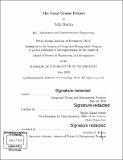The Good Grains Project
Author(s)
Sharma, Nidhi,S.M.Massachusetts Institute of Technology.
Download1120720863-MIT.pdf (13.01Mb)
Other Contributors
Massachusetts Institute of Technology. Engineering and Management Program.
System Design and Management Program.
Advisor
Sanjay Emani Sarma.
Terms of use
Metadata
Show full item recordAbstract
Foodgrains (like wheat, peanuts, etc.) gain moisture when they are stored, which leads to variation in weight and deterioration in quality. These commodities are sold by weight in India, and therefore, variable weight directly impacts the economic value of the produce. In addition, the quality of foodgrains is tightly coupled to their moisture content. For instance, if the moisture content of wheat is higher than 12%, it is not purchased by the local agriculture markets at the market price. Such produce is either rejected (sent back to the farmer for drying) or purchased at a much lower (discounted) price owing to the quality depreciation because of high moisture content. The depreciation is due to the presence of unwanted moisture, which results in growth of fungi. Fungal interaction with foodgrains leads to formation of Aflatoxin, which is one of the most toxic and carcinogenic substances known. Current solutions for detecting aflatoxin or uncontrolled moisture are either time consuming and expensive lab tests, or inefficient mechanisms based on unreliable sampling, which are inaccessible to farmers, warehouse managers and consumers, and provide a poor generalisation of the grain quality at the best. I have attempted to develop an easy to use and low-cost product that helps detect the presence of uncontrolled moisture in foodgrains, which is closely correlated to the presence of Aflatoxin. The product comes in the form of a smart RFID sensor, embedded in each of the gunny bags that store commodities like wheat, rice, etc. While a usual RFID tag only detects the presence of an object, the innovation here lies in creating an RFID tag that also responds to the moisture content of the commodity in the bag. This product can be a path-breaking innovation for warehousing corporations in India, as it will help keep a track of quality of millions of tonnes of food commodities, at a much deeper level in the supply chain.
Description
Thesis: S.M. in Engineering and Management, Massachusetts Institute of Technology, System Design and Management Program, 2019 Cataloged from PDF version of thesis. Includes bibliographical references (pages 103-106).
Date issued
2019Department
Massachusetts Institute of Technology. Engineering and Management ProgramPublisher
Massachusetts Institute of Technology
Keywords
Engineering and Management Program., System Design and Management Program.